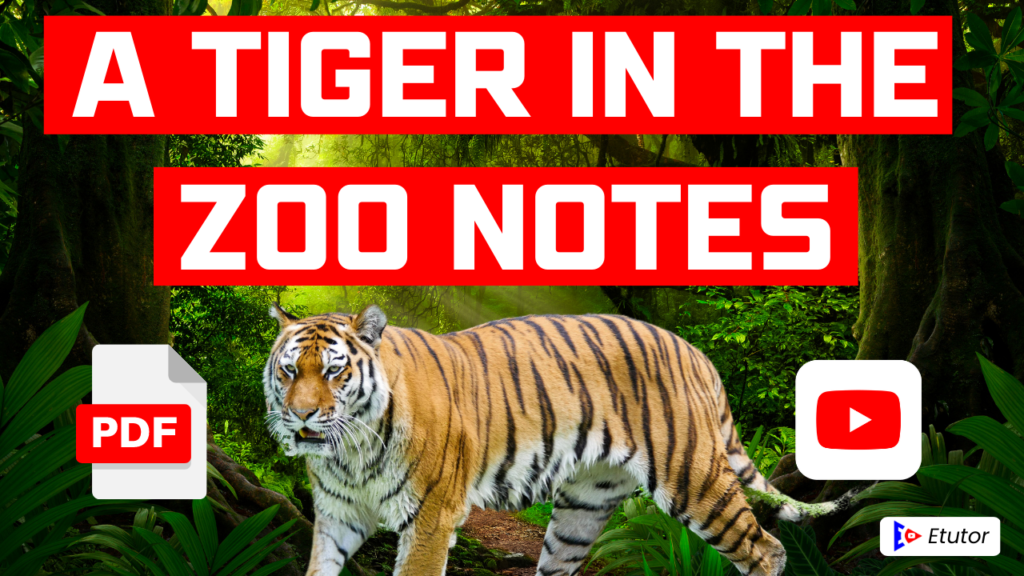Greetings, friends! Welcome to etutorguru. Within this piece of writing, we have furnished CBSE Notes for Class 10 English Poem 3, “A Tiger in the Zoo” and NCERT solutions .
You can visit our youtube channel – ETUTOR ANIMATION for Animated Videos of Class 10
Tiger in the Zoo Class 10 English Notes ETUTOR
What You’ll Find In This Post –
- About the Poet : A Tiger in the Zoo
- Short Summary : A Tiger in the Zoo
- Detailed Summary : A Tiger in the Zoo
- Theme of the Poem : A Tiger in the Zoo
- PDF Notes Download : A Tiger in the Zoo
- Question/Answers : A Tiger in the Zoo
About the Poet : A Tiger in the Zoo

The poem “A Tiger in the Zoo” is written by Leslie Norris, who was a Welsh poet and a short story writer. He was born on 21st May 1921 in Merthyr Tydfil, Wales, and he passed away on 6th April 2006 in Swansea, Wales. He is known for his realistic portrayal of life in Wales and his love for nature. His literary works were often characterised by themes of loss, separation, and longing.
Short Summary : A Tiger in the Zoo
Leslie Norris’ poem describes the misery and helplessness of a caged tiger living in a zoo. The poet describes what his life would have been like if he had been a free animal. The poet attempted to explain the condition of animals trapped by humans for their own amusement.
The poem opens with a description of a really lovely tiger wandering in his small cage. He has lovely stripes on his skin and velvety soft paws. Yet the tiger is not pleased and is irritated at being imprisoned in the cage.
According to the poet, if the tiger had not been confined to the zoo cage, he would have been hidden behind the long grass near a body of water in order to catch its prey, the deer. He would also have terrorised the residents of the communities surrounding the forest. Yet the truth is just the reverse. He was locked in a cage built of heavy building materials, and he was helpless inside. He couldn’t demonstrate his authority to the tourists, therefore he never tried to scare them.
The poet describes the tiger as impotent and in pain. He claims that he is alone at nights as well, hearing the voices of police patrol trucks and gazing at the stars. The tiger’s personality has been completely altered by his imprisonment. The poet is attempting to convey that the animal, which is known for its fearlessness and independence, is imprisoned and miserable as a result of human beings who seek pleasure from staring at him in the zoo cage.
Theme of the Poem : A Tiger in the Zoo
The theme of the poem is the captivity of animals in zoos and the consequences of depriving animals of their natural habitat. The poem highlights the plight of the tiger, which is a magnificent creature, but is now trapped in a small space and is unable to run or hunt. The poet shows how the tiger’s captivity has made it feel trapped and helpless, and how its true nature is hidden from the people who come to see it in the zoo. The poem explores the theme of freedom, and how the loss of freedom can affect the behaviour and emotions of animals.
Detailed Summary : A Tiger in the Zoo
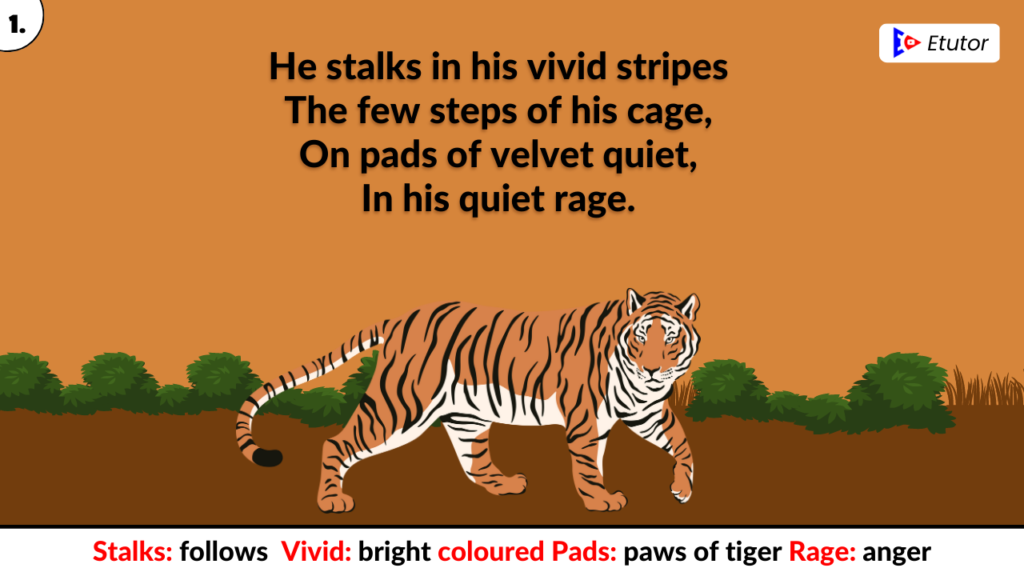
In this passage, the poet claims that the caged tiger in the zoo moves around inside of its vibrantly coloured skin. He adds that the cage is small and difficult to traverse in, so the tiger can only move a few steps at a time. Because of his extremely soft feet, which resemble velvet, no one can hear the sound of the tiger’s footsteps when he walks. The tiger makes a quiet circle around the small confines of his cage in an effort to contain his rage. Because he is not free, he is outraged.

Literary Devices/ Poetic Devices :
Rhyme scheme: abcb (cage-rage)
Personification: Due to the poet’s usage of the pronoun “he,” the tiger is personified.
Metaphor: The paws of tigers are contrasted to velvety pads.
Enjambment: Without a punctuation mark, the sentence continues on to the next line.
Imagery: A tiger-related image is attempted by the poet (He stalks in his brilliant stripes). His cage’s few steps)
Consonance: sound of ‘s’ use (stalks, his, stripes)
Assonance: use of the vowel “I” (in his vivid stripes)
Oxymoron: using adjectives with opposing meanings (quiet rage)

In order to readily trap a deer to use as food, the poet claims that if this tiger had been free, he would have hidden himself behind the tall grass close to water sources. In essence, the poet is trying to convey that a tiger’s natural habitat is a forest, where he can hunt and consume his food, as opposed to a cage, where he is unable to do so.
Literary Devices/ Poetic Devices:
Rhyme: abcb rhyme scheme (grass-pass)
Enjambment: Without any punctuation, the line continues to the next line. Deer pass is traversed while sliding.
Alliteration: use of the letter “p” at the beginning of two words (plumperpass)
Imagery: The poet has made an effort to portray the behaviours of a tiger (lurking in shadow).
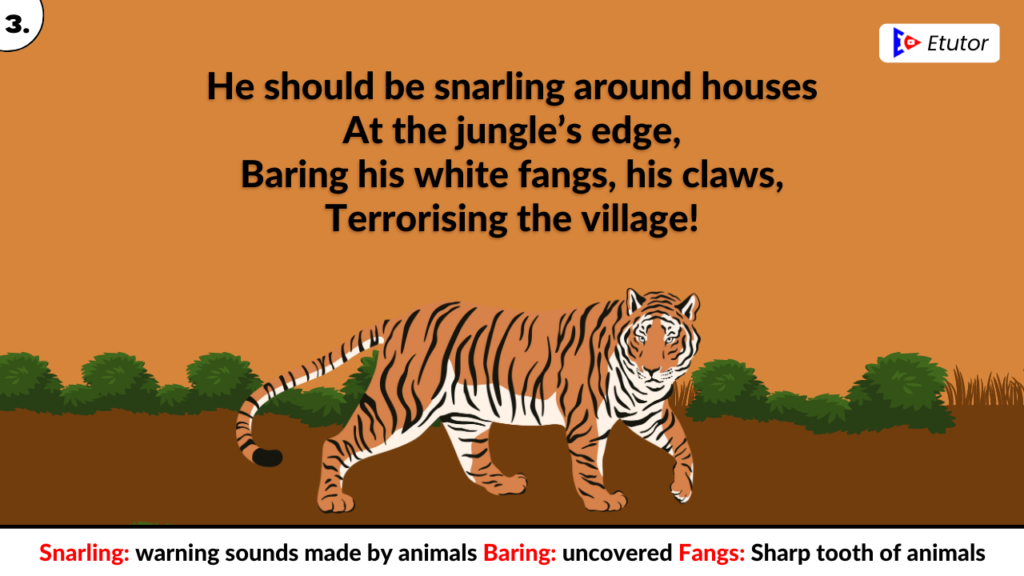
According to the poet, if the tiger had been left to his own devices, he would have hissed at the houses that were situated on the edge of the woodland. With his razor-sharp teeth and claws, he would terrorise people. The villagers’ residents would be terrified by this.
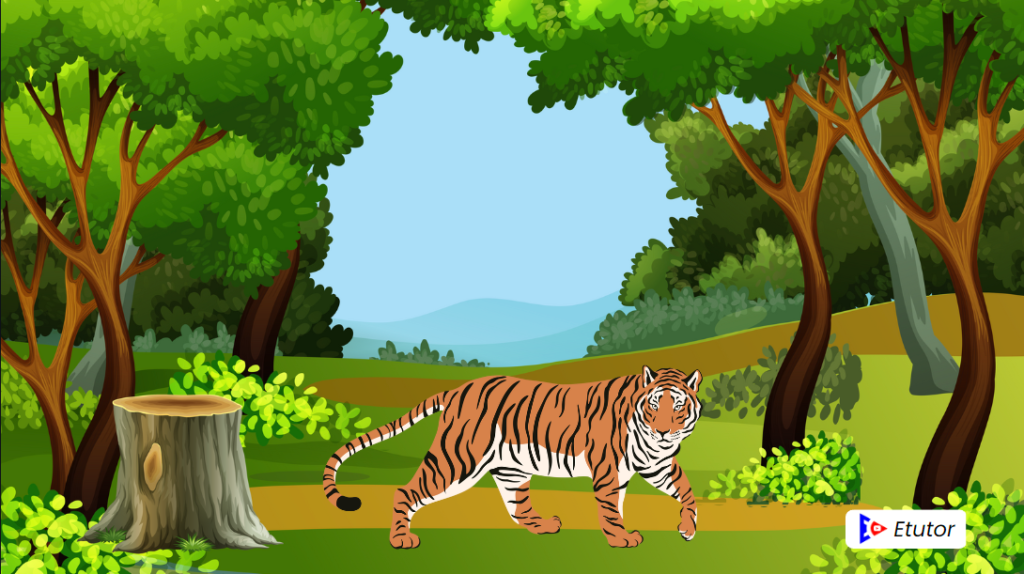
Literary Devices/ Poetic Devices:
Rhyme Scheme:The rhyme system is abcb (edge, village)
Enjambment: Without any punctuation, the line continues to the next line. (He ought to be growling about homes. At the edge of the jungle)
Onomatopoeia: utilising language to convey sound (snarling)
Assonance: ‘o’ and ‘I’ vowel use (should, around, homes) (Baring, his, white, his)
Consonance: using the consonant sound “s” (his, fangs, his, claws)
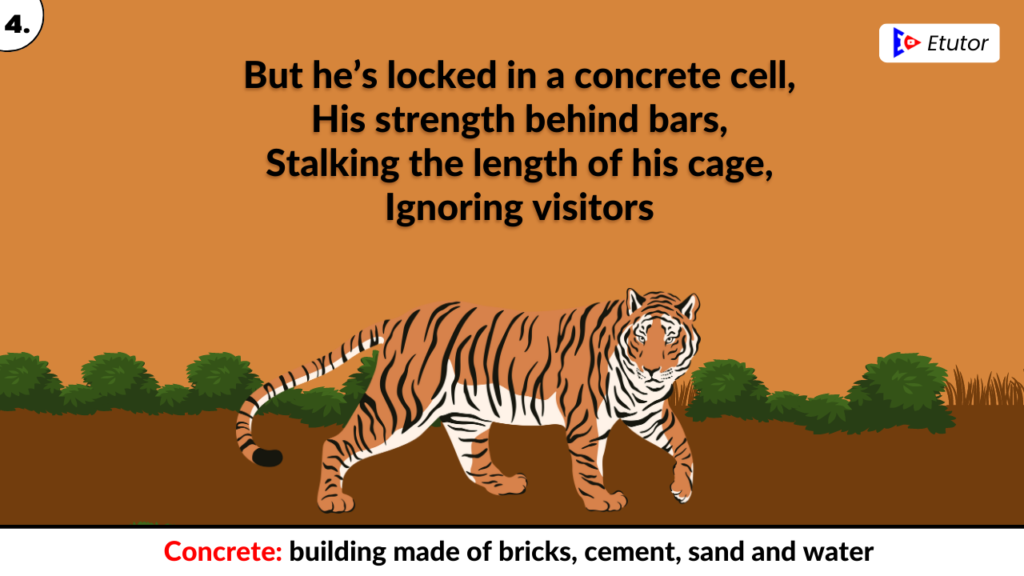
The poet now confronts the truth about the tiger that is housed in the cage. He claims that the tiger is housed in a sturdy cell built of sturdy construction material. He continues by saying that, just as the tiger is imprisoned, so too is his ferocity. He simply prowls around the cage. Because the cage limits his power, he never tries to terrorise the guests. He can’t assault the tourists, therefore he never tries to terrorise them.
Literary Devices/ Poetic Devices:
Rhyme Scheme: The rhyme system is abcb (bars-visitors)
Personification: Due to the poet’s usage of the pronoun “he,” the tiger is personified.
Assonance: use of the vowel ‘e’ (he, locked, concrete, cell)
Consonance: usage of the consonant’s’ (his, strength, bars)
Alliteration: use of the sound “b” to begin two words (behind bars)

According to the poet, the patrol cars’ sounds can be heard by the tiger at night. Patrolling cars are the police cars that are utilised for nighttime patrol. The tiger consequently hears the sounds of these autos at night. Then, with bright eyes, he looks up at the stars. The poet aims to convey that the tiger is unhappy and helpless because he is imprisoned in the cage. He therefore focuses on the stars in the night sky in an effort to focus his attention there.
Literary Devices/ Poetic Devices:
Rhyme Scheme: The rhyme system is abcb (cars-stars)
Enjambment: Without a punctuation mark, line three continues to line four. (And maintains a dazzling gaze.) look up at the beautiful stars.)
Alliteration: use of the letter “h” to begin two words (he hears)
Assonance: using the “I” sound (with, his, brilliant)
PDF Notes Download : A Tiger in the Zoo
Question/Answers : A Tiger in the Zoo
Q1. Read the poem again, and work in pairs or groups to do the following tasks.
(i)Find the words that describe the movements and actions of the tiger in the cage and in the wild. Arrange them in two columns.
(ii)Find the words that describe the two places, and arrange them in two columns. Now try to share ideas about how the poet uses words and images to contrast the two situations.
Ans. (i)
| Movements and actions of the Tiger in the cage | Movements and actions of the Tiger in the wild |
| Stalking | Lurking |
| (Stepping) On pads of the velvet quiet | Sliding |
| Ignoring | Snarling |
| Hears (hearing) | Baring |
| Stares (staring) | Terrorising |
(ii)
| Places in the Cage | Places in the Wild |
| Cage | Through long grass |
| Concrete cell | Near the water hole |
| Behind bars | Around houses |
| The length of his cage | At the jungle’s edge |
Q2. Notice the use of a word repeated in lines such as these:
(i) On pads of velvet quiet, In his quiet rage,
(ii) And stares with his brilliant eyes At the brilliant stars. What do you think is the effect of this repetition?
Ans.
(i) In lines 1 (velvet quiet) and 2, the word quiet appears twice (quiet rage). When a certain action is emphasised, the poetic device of “repetition” is used. The adjective “quite” is used to describe the tiger’s velvety pads’ “silent” movement. The word “quiet” in the second phrase refers to repressed or silent fury.
(ii) Brilliant appears twice in this sentence. As “bright eyes” at first, and then as “dazzling stars” later. It means that the tiger’s bright eyes are just as brilliant as the stars in the night sky.

